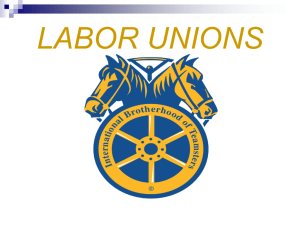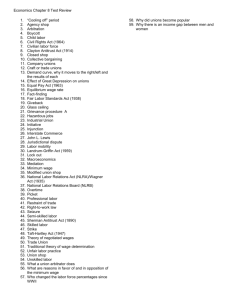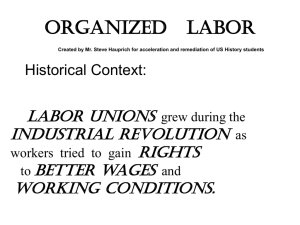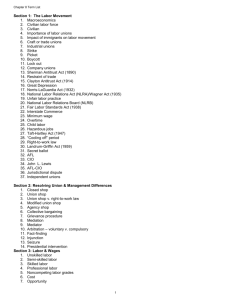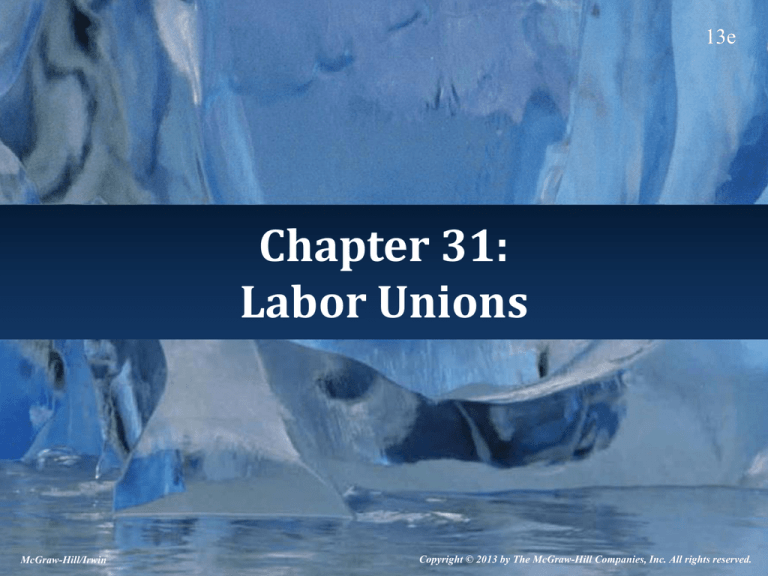
13e
Chapter 31:
Labor Unions
McGraw-Hill/Irwin
Copyright © 2013 by The McGraw-Hill Companies, Inc. All rights reserved.
Unions
• A labor union strives to consolidate market
power on the supply side of the labor
market.
• In the past few decades union power in the
private sector has waned, but in the public
sector it has grown.
• This reflects, in some ways, the transition of
America from a goods-based economy
toward a services-based economy.
31-2
Learning Objectives
• 31-01. Know how unions secure high wages.
• 31-02. Know the factors that affect
collective bargaining outcomes.
• 31-03. Know how unions affect nonunion
wages.
31-3
The Labor Market
• The market labor supply includes all
individuals willing and able to work at
alternative wage rates.
• The market labor demand includes all the
workers the firms are willing and able to hire
at alternative wage rates.
• Together they determine the equilibrium wage
rate, where the quantity of labor supplied
equals the quantity of labor demanded.
31-4
The Labor Market
• In reality, there are several labor markets,
separated by many factors.
– Each skill has its own market.
– Markets are also separated by geography.
• Any particular labor market includes just a tiny
portion of the nation’s workers.
• Thus market power in labor markets is likely to
be more effective in specific areas, occupations,
and industries.
31-5
Labor Unions
• To be successful, a union must be able to exert
control over the labor market supply curve.
– A union wants to be a monopoly provider of
workers.
• A union will concentrate on a specific part of
the labor market:
– Industrial unions concentrate on a particular
industry.
– Craft unions represent workers with a particular
skill.
31-6
Union Objectives
• The main union goal we will focus on is to
raise the wages of their members.
• Other objectives may include
– Improved working conditions.
– Job security.
– Retirement (pension) funds.
– Vacation time.
– Health insurance and other benefits.
31-7
Use of Union Power
• One worker would make an individual labor
versus leisure decision concerning a job.
• A union, on the other hand, evaluates job
offers on the basis of the collective interests
of its members.
31-8
Use of Union Power
• Since unions act as a
monopolist, they face a
downward-sloping
labor demand curve.
• The marginal wage
curve slopes
downward, too.
– Marginal wage: the
change in total wages
paid associated with a
one-unit increase in the
number employed.
31-9
Use of Union Power
• Because the labor demand curve slopes
downward, if more workers are to be hired,
wage rates must fall.
– Marginal wage falls also.
– Marginal wage can go negative. No union will
accept a negative marginal wage.
• To find out what level of (positive) marginal
wage a union will accept, we must add the
labor supply curve.
31-10
Use of Union Power
• The intersection of
the marginal wage
curve and the labor
supply curve sets
the union’s desired
number to be
employed (point u).
• The wage for this
number is shown by
point U.
31-11
Use of Union Power
• At the wage rate of
$4, more people
want to work
(point N) than
there are jobs
(point U).
• Thus unions must
be able to exclude
some workers
from the market.
31-12
Exclusion
• The union must exclude workers to keep
wages high.
– Union members must not compete against each
other.
– They must agree to withhold labor (strike) if
called upon to do so.
– A union shop can be established, requiring all
workers in a plant to be union members.
31-13
The Extent of Union Power
• Union power grew in the
private sector of
manufacturing but peaked
in the 1950s, as the United
States transitioned into
service industries.
• Unionization rates have
declined in the private
sector but have risen in the
service-oriented public
sector.
31-14
Employer Power
• On the demand side of a labor market, there
is power also, if one firm dominates the
hiring in a particular industry or area.
– Monopsony: a market in which there is only one
buyer.
– A monopsonist must face the entire market
supply curve.
– It can hire additional workers only if it offers a
higher wage.
31-15
Employer Power
• Marginal factor cost
(MFC): the change in
total costs that results
in a one-unit increase in
the quantity of a factor
(in this case, labor)
employed.
– The MFC will exceed the
wage rate because
additional workers can
be hired only if the wage
rate for all workers is
raised.
– The MFC curve lies above
the labor supply curve.
31-16
Employer Power
• Point U indicates the
quantity of labor a
monopsonist will want
to hire. Point G shows
the wage that must be
paid to get that many
workers.
• If the market were
competitive, point C
would show the wage
and number hired.
31-17
Employer Power
• Recall that the demand
curve for labor is the
firm’s marginal
revenue product (MRP)
curve.
• A monopsonist is a
profit-maximizing firm.
– The profit-maximizing
level of input (labor) use
exists where marginal
revenue product (MRP)
equals marginal factor
cost (MFC).
– Point U determines how
many to hire.
31-18
Collective Bargaining
• Here is the conflict:
– The union wants a wage rate that is higher than
the competitive wage.
– The monopsonist wants a wage rate that is
lower than the competitive wage.
• The market, therefore, is a bilateral
monopoly, where there is only one buyer
and only one seller.
31-19
Collective Bargaining
• In a bilateral monopoly, wages and the
number employed are not determined by
supply and demand.
• They are determined by collective
bargaining – direct negotiations between
the employer and the union.
31-20
Collective Bargaining
• The union wants
point U and the
monopsonist wants
point G.
• Point C is competitive
equilibrium.
• Collective bargaining
will find a
compromise in the
shaded triangle.
31-21
Collective Bargaining
• Negotiating power comes from the ability to
withhold labor (the union’s power) or jobs
(the monoposonist’s power).
• There is pressure to settle. Both sides lose if
there is a strike or a lockout.
• Most collective bargaining events conclude
without a strike or a lockout.
31-22
The Impact of Unions
• Wages of union members are higher than
wages of nonunion workers.
– Much of this difference is due to the negotiating
power and the restrictive membership of
unions.
– If unions restrict the number of workers, union
labor supply shifts left and union wages rise.
– Displaced nonunion workers migrate into
nonunion locations. Labor supply shifts right
and nonunion wages fall.
31-23
The Impact of Unions
• Productivity can also be affected by unions.
– Unions bargain about working conditions, which
may affect how goods will be produced.
– Union rules may inhibit productivity, which would
increase costs and possibly lead to price increases.
• Politics: unions contribute heavily to the
campaigns of politicians who support their
cause.
– Their success is seen in minimum wage laws, work
and safety rules, and retirement benefits.
31-24


